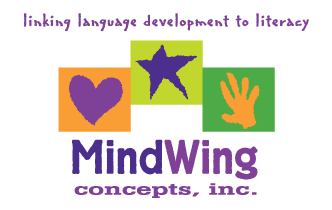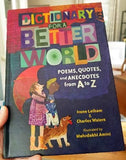Menu
-
- Home
-
About Us
-
The Approach
-
Linking Language & Literacy
-
MindWing Learning
-
Learning Resources
-
SHOP
-
Blog
-
- About MindWing
- Our People
- Contact Us
- Your Account
- Login
-
Spain (EUR €)

MindWing Concepts Blog

Tech Tuesday: Summer Study Series and “What Does It Mean to Be Social?”
August 24, 2020
 For our last 😢entry in our “Summer Study Series” for 2020, we look at a perspective on social cognition with a twist: how are children with significant speech sound disorders, such as apraxia of speech, impacted within the sequence of developing social competencies? This article, What Does It Mean to Be Social? Defining the Social Landscape for Children With Childhood Apraxia of Speech, is provided by Nancy Tarshis, Michelle Garcia Winner, and Pamela Crooke (2020) and was released within ASHA’s Perspectives (Special Interest Group 2) journal available to anyone with a SIG membership in any specialty. For others, the article is behind a paywall, so I hope this review at least will be helpful...
For our last 😢entry in our “Summer Study Series” for 2020, we look at a perspective on social cognition with a twist: how are children with significant speech sound disorders, such as apraxia of speech, impacted within the sequence of developing social competencies? This article, What Does It Mean to Be Social? Defining the Social Landscape for Children With Childhood Apraxia of Speech, is provided by Nancy Tarshis, Michelle Garcia Winner, and Pamela Crooke (2020) and was released within ASHA’s Perspectives (Special Interest Group 2) journal available to anyone with a SIG membership in any specialty. For others, the article is behind a paywall, so I hope this review at least will be helpful...

Tech Tuesday: Summer Study Series on an RCT of Narrative Intervention for Adolescents
July 23, 2020 1 Comment
 We look at an exciting piece of research from last summer (July/August 2019), Improving storytelling and vocabulary in secondary school students with language disorder: a randomized controlled trial* (full article available at link). In this article, Joffe, Rixton and Hulme describe a randomized controlled trial (RCT) involving both narrative and vocabulary intervention for secondary students in the UK. It is notable because RCTs in language intervention are relatively rare, and considered a high level of evidence. ASHA, on a scale of evidence quality, rates “well designed randomized controlled trials” as level 1b, 2nd on a 6-point scale of evidence; these are research studies in which intervention groups are compared to a control group in which no intervention was provided. Additionally, interventions for adolescents with persistent language problems are less researched, so this study is an important one!...
We look at an exciting piece of research from last summer (July/August 2019), Improving storytelling and vocabulary in secondary school students with language disorder: a randomized controlled trial* (full article available at link). In this article, Joffe, Rixton and Hulme describe a randomized controlled trial (RCT) involving both narrative and vocabulary intervention for secondary students in the UK. It is notable because RCTs in language intervention are relatively rare, and considered a high level of evidence. ASHA, on a scale of evidence quality, rates “well designed randomized controlled trials” as level 1b, 2nd on a 6-point scale of evidence; these are research studies in which intervention groups are compared to a control group in which no intervention was provided. Additionally, interventions for adolescents with persistent language problems are less researched, so this study is an important one!...

Tech Tuesday: Return of the Summer Study Series!
June 29, 2020
 For the past several years in this space we have presented a “Summer Study Series” highlighting peer-reviewed articles and research relevant to narrative and expository assessment and intervention. For 2020, we begin with A Systematic Review of Academic Discourse Interventions for School-Aged Children With Language-Related Learning Disabilities (Peterson, Fox & Israelsen, 2020). Systematic reviews are a higher tier of research applying selection criteria and metrics to determine effect sizes of studies of particular types of interventions. In other words, a study of studies specific to narrative and expository (more the latter) discourse...
For the past several years in this space we have presented a “Summer Study Series” highlighting peer-reviewed articles and research relevant to narrative and expository assessment and intervention. For 2020, we begin with A Systematic Review of Academic Discourse Interventions for School-Aged Children With Language-Related Learning Disabilities (Peterson, Fox & Israelsen, 2020). Systematic reviews are a higher tier of research applying selection criteria and metrics to determine effect sizes of studies of particular types of interventions. In other words, a study of studies specific to narrative and expository (more the latter) discourse...

Listen. Words Have Power
June 16, 2020
 We stand in support of racial equality. To be anti-racist, people must be able to listen, use their voices, take perspective, tell their stories, and express their thoughts at home, in school and in life. We are committed to continuing to focus our professional development on supporting children in “telling their story” as well as sharing narrative and expository selections of children’s literature that are written by Black authors and People of Color, that have characters representing multiple cultures, as well as those books that take on themes and topics such as racism, racial justice, and diversity. This is Maryellen Rooney Moreau’s 50th year as a speech/language pathologist specializing in communication and discourse. Her passion is helping children to think...
We stand in support of racial equality. To be anti-racist, people must be able to listen, use their voices, take perspective, tell their stories, and express their thoughts at home, in school and in life. We are committed to continuing to focus our professional development on supporting children in “telling their story” as well as sharing narrative and expository selections of children’s literature that are written by Black authors and People of Color, that have characters representing multiple cultures, as well as those books that take on themes and topics such as racism, racial justice, and diversity. This is Maryellen Rooney Moreau’s 50th year as a speech/language pathologist specializing in communication and discourse. Her passion is helping children to think...

Tech Tuesday: Placing Expository Structures/Icons in Context
May 27, 2020
 MindWing’s icons for narrative and expository language can make conversation about any TOPIC a strategic and scaffolded one. Last month I recorded a free webinar with Maryellen (Technology Tools to Engage Children in Science & Social Studies During Distance Learning Sessions) on expository text structures (ThemeMaker®) and using MindWing’s icons in context with technology resources. In this post, I’ll be giving some examples of expository-embedded resources online that can be used in teletherapy sessions. By expository-embedded, I mean resources that don’t necessarily say one, another, also, or first, then next, but can be used to form conversations and reviews with structures like List and Sequence. Take for example, Google Earth. This now-web-based interactive globe allows you to simply search and navigate in order to provide tours, and what is a tour but a LIST (or SEQUENCE) of places within a main idea or overall location...
MindWing’s icons for narrative and expository language can make conversation about any TOPIC a strategic and scaffolded one. Last month I recorded a free webinar with Maryellen (Technology Tools to Engage Children in Science & Social Studies During Distance Learning Sessions) on expository text structures (ThemeMaker®) and using MindWing’s icons in context with technology resources. In this post, I’ll be giving some examples of expository-embedded resources online that can be used in teletherapy sessions. By expository-embedded, I mean resources that don’t necessarily say one, another, also, or first, then next, but can be used to form conversations and reviews with structures like List and Sequence. Take for example, Google Earth. This now-web-based interactive globe allows you to simply search and navigate in order to provide tours, and what is a tour but a LIST (or SEQUENCE) of places within a main idea or overall location...

May 6, 2020: Thoughtful poetry for all times…
May 06, 2020 1 Comment
 Woodson, J. (2014). Brown Girl Dreaming. NY: Putnam. This is a book of poetry centering on the author’s life experiences growing up in Ohio. She remembers life as a child and applies these memories to her future. There are two poems that I would like to cite: “every wish, one dream,” (pages 313–314) and “it’ll be scary sometimes,” (pages 13–14). The first selection is about Woodson’s dream of becoming a writer. As many writers have, she has read much and remembered the themes, lines of stories and poems, and their life lessons. As I read the passage to you, think about her expression of her life’s goal. The second poem is about a memory from early life stories about family experiences from past generations. Handout Available...
Woodson, J. (2014). Brown Girl Dreaming. NY: Putnam. This is a book of poetry centering on the author’s life experiences growing up in Ohio. She remembers life as a child and applies these memories to her future. There are two poems that I would like to cite: “every wish, one dream,” (pages 313–314) and “it’ll be scary sometimes,” (pages 13–14). The first selection is about Woodson’s dream of becoming a writer. As many writers have, she has read much and remembered the themes, lines of stories and poems, and their life lessons. As I read the passage to you, think about her expression of her life’s goal. The second poem is about a memory from early life stories about family experiences from past generations. Handout Available...
